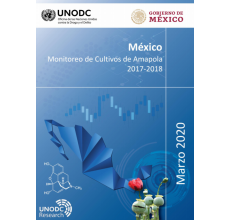México: Monitoreo de Cultivos de Amapola 2017-2018

UNODC. United Nations Office on Drugs and Crime
This report presents the fourth results of the monitoring period 2017–2018 including the estimation of the total area cultivated with poppy (ha), the yield of opium gum (kg/ha), the potential production of dry opium (mt) and the concentration of morphine in the opium gum (%). Furthermore, eradication and seizures reported and based on the efforts to eradicate illicit crop cultivations by the Government of Mexico are presented in the report. The results of this survey and the eradication data from the Government show that the main areas of poppy cultivations are located in the states of Sinaloa, Chihuahua and Durango (also known as the “Golden Triangle”), as well as in the states of Guerrero and Nayarit. Most poppy cultivations are found in remote areas with unpaved roads and trails that are difficult to access. For the 2017-2018 study, the results of the opium poppy cultivation area were obtained through the analysis and identification of the opium poppy crops with satellite images and verified with aerial photography collected by overflights in field work. The 2017-2018 study was conducted under the same methodology used in 2016-2017, and thus results are statistically comparable. In addition, opium gum yield and morphine content estimation results were obtained through measurements and data collection during four field work campaigns between October 2017 and April 2018. This can be seen as a first effort to provide reliable yield and production estimates in Mexico according to the international standards. The objective of the project is to continue updating the yield figures at each annual survey and, in the medium term, to develop a unique mathematical model for the Mexican case. In order to achieve this, the project will continue working on improving the data collection protocols.
The European Commission is preparing a third phase of this programme, therefore COPOLAD will be back at the beginning of 2021.

